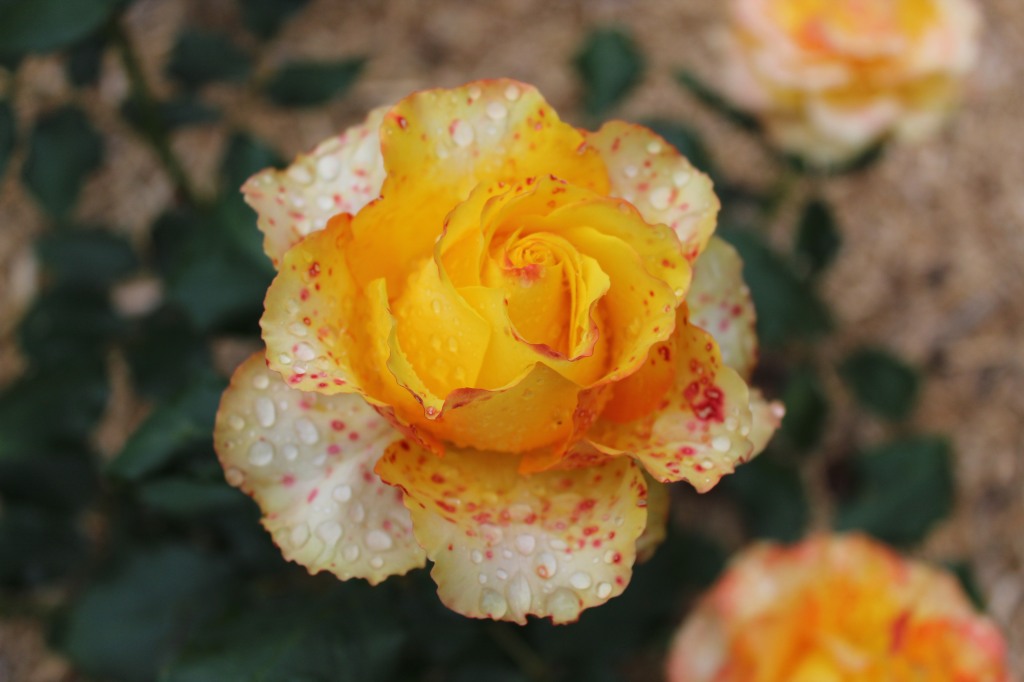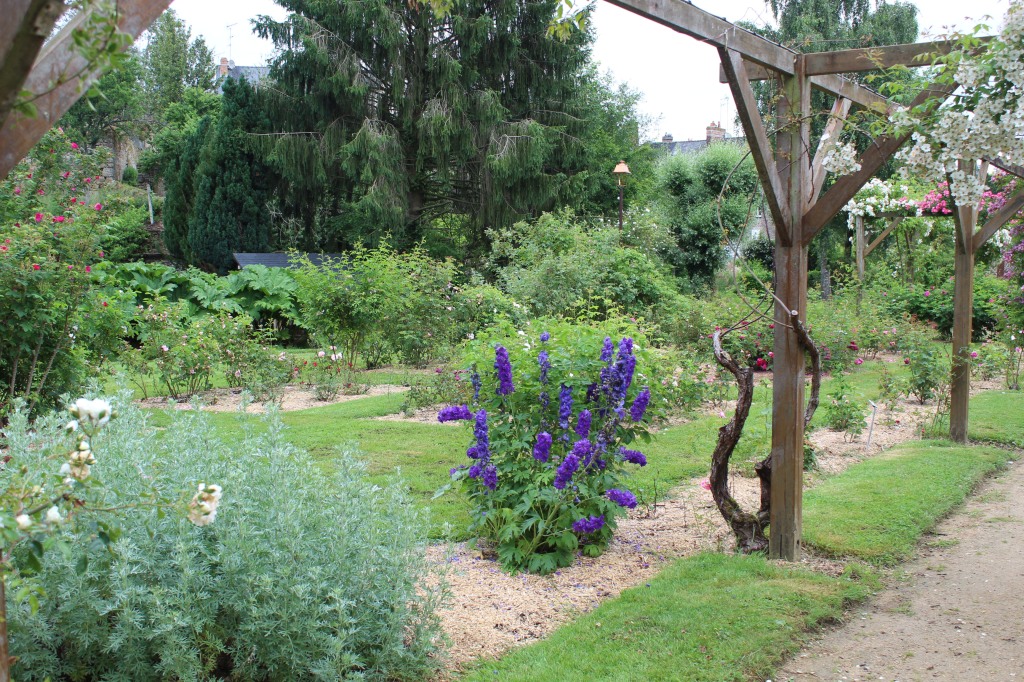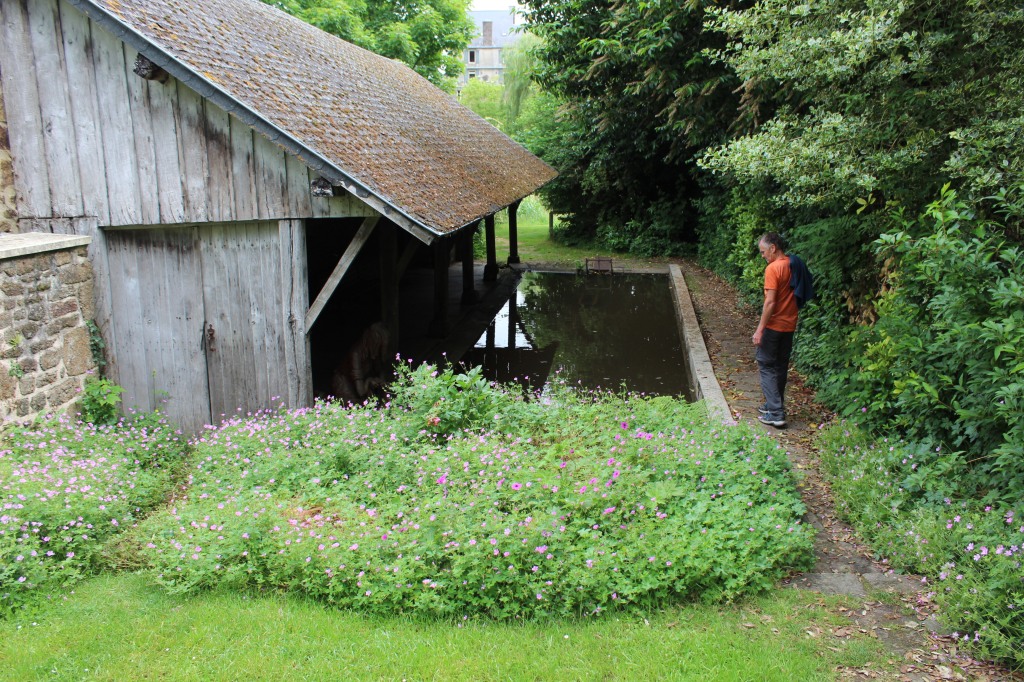We’ve had happy associations with Lassay-les-Châteaux for more than twenty years so perhaps I am a bit biased when I suggest it must surely be one of the prettiest towns in Mayenne. Small, friendly and charming, there are many attractions including the imposing medieval castle set above a small lake, a pleasant walk in the surrounding countryside to discover the other two (ruined) castles, a beautiful medieval garden, cafe terraces where you can sit and watch the world go by, and a bustling Wednesday morning market where at least one of our offspring loved to go for the treat of a galette saucisse. At this time of year, though, there is no doubt that the rosaraie is the jewel in the town. A public rose garden just a few steps from the town centre, it is a peaceful place bursting with colour and scent, somewhere for all to enjoy; there are picnic tables, a children’s playground, and many benches and paths in a space that is small enough to feel intimate, large enough to spend time wandering and discovering. Surrounded by old buildings of honey-coloured stone, their productive vegetable gardens running down to a stream and swifts looping and calling overhead, it is a pleasant spot to linger and I am never surprised to see people sitting and enjoying the tranquility – some reading, others just quietly soaking up the beauty of the place.

The roses are gorgeous, so many different varieties all at their very best in a rainbow of colours: climbers, ramblers, bush, miniature, groundcover, tea, floribunda, grandiflora, polyantha, English, Gallica, China, Damask, Bourbon, moss, noisette, rugosa . . . whatever takes your fancy, they are here. I’ve never been a fan of formal planting schemes, always preferring something wilder and unconstrained, but even I find these colours and scents irresistible!

I also love the fact that the garden is being managed organically: the beds are deeply mulched with chopped straw to suppress weeds and there are a number of lacewing boxes and a bug hotel to encourage natural aphid predators. There is a beehive set on a wall and the relatively new addition of possibly the most impressive chicken palace run I have ever seen. Chickens in a public garden? Reading the information board, I was impressed with what an inspired idea this is, a community solution to the problem of rubbish. Several years ago, in an attempt to reduce the amount of household waste going into landfill and to encourage more recycling, the local council introduced a charge-by-weight scheme for bags deposited in household rubbish containers. However, this posed a problem for people living in town who have no facilities or space for making compost; the solution was to install the chicken run fitted with wooden bins where locals can deposit their kitchen waste for the chickens to eat and scratch down into compost. It’s been a huge success, not just from a waste disposal angle but also as something of an attraction; I’ve always found chickens to be good company and it seems plenty of others do, too, spending a few moments just watching the birds go about their business. Perhaps this is something that could catch on in similar situations?



A short walk from the rosaraie is a charming garden opened in 2001, based on a medieval design – very fitting, with the round towers and turrets of the castle as a dramatic backdrop.

It’s a while since we’ve visited and it was amazing just how mature it has become, a reminder of how quickly trees and plants will grow and fill spaces given the right conditions. I love the fact that the plants chosen are those known to have existed at least from medieval times, and I feel a certain comfort in that essence of history and continuity. I particularly like the jardin des simples, crammed as it is with aromatic and medicinal plants: there is so much inspiration there!

The previous owners of our house left an everlasting sweet pea in a large pot which I feel it is far more suited to being in the ground. I’ve been wondering exactly what to do with it and here was the answer: let it scramble unfettered among golden yarrow, what a fabulous colour combination they make.

The potager also draws me with its espaliered fruit trees, soft fruit bushes and ‘medieval’ vegetables. Like parts of the rose garden, it’s a little too formal for my liking but fascinating, none the same.

I have just planted a hedge of cardoons and I’m hoping it won’t be too long until they are also taller than Roger! I loved the underplanting with alpine strawberries, left to scramble freely and covered in tiny fruits – that’s definitely one to try at home.

The mix of planting appeals to me and there is definitely something of permaculture here with single vegetables side by side in heavily mulched beds. It’s the sort of thing I’m planning for the mandala bed we’ve started making, a colourful and joyful explosion of food plants in the middle of a flower garden.

Below the medieval garden is a lavoir, an old wash house which is one of many in Lassay, the evocative wooden carving serving as a reminder of a life in tougher times.


From there, it is just a few steps to the lake and a fine view of the castle reflected in the still water.

Looping back through the town to the rose garden, we passed several municipal planting schemes and patches of garden, full of colour and life and making Lassay very much a ville fleurie to be savoured. No matter how many times I have been there and in whatever season, it is a place that never fails to delight.



I certainly came home inspired, too. I’m not one to romanticise history – let’s be honest, life in the Middle Ages was short and harsh for many people – but there was much in the medieval garden to set me thinking. I’m all for a simple life but I have to admit I’m grateful not to have to do our laundry in a lavoir; however, the wooden washerwoman and huge bed of soapwort in the jardin des simples reminded me once more that it is time to get back on track with all things herbal. I started my exploration of soapwort last year in Asturias, growing a good sized plant from the gift of a root which I was able to lift and move here with us in December. I split the plant and settled it into two places; the bigger of the two has already made a decent show of things and I think there would be no harm in harvesting some stems and leaves now for my first soapy trial. Eventually, I’m planning to let it run amok in as big a space as it wants so that we have enough to use for laundry, dishwashing and in the bathroom but to start things off, I’ve decided to combine it with sage and rosemary to make a herbal shampoo. I’m hoping this will be the start of something great.


Looking to expand my knowledge and use of plants domestically and therapeutically, I’ve treated myself to a copy of A Modern Herbal by Alys Fowler which I’ve bought from World of Books, an ethical secondhand book company. (As an aside, I’ve always been very pleased with the books I’ve bought from them and I’m happy to continue supporting them – especially at only £2 for international shipping). I already have a herbal, but it is very dated and a peep at the preview of this new one suggests the far wider scope and coverage I’m looking for; for example, there is a section about using globe artichokes and cardoons, both of which I’ve recently planted and would like to make full use of once established. Once the book arrives, Roger will have a quiet life while I devour every page . . . while most probably making a very long wishlist for the garden.

I also know that there is a copy of The Hedgrow Handbook by Adele Nozedar of Breacon Beacons Foraging waiting for me at Vicky’s house for collection when we are finally allowed to travel and visit once again (please let it be soon). I bought a gift voucher for Adele’s foraging workshop for Vicky’s 30th birthday which we had planned to celebrate with her last year; unfortunately, Covid put paid to that, but realising how frustrated and sad I was, Adele swung into action. Living near Vicky, she offered to deliver the voucher by hand (in a Covid secure way, of course), taking a posy of June flowers from her garden and singing a hearty rendition of ‘Happy Birthday To You’ on the doorstep! I’ve never met Adele and I’m not being paid to advertise her business or books but she is most definitely one of life’s lovely people and I think it’s important to give credit where it is due. Having found so much enjoyment in foraging for elderflowers and nettles in recent weeks, I can’t wait to get my hands on her book!

Having put woolly things on hold for several months, I’ve started to think about natural dyes again, spurred on by the fact that Roger was kind (or daft?) enough to find room for my box of Dark Art materials on his last trip to Asturias (there’s even a faint whisper about my spinning wheel coming next time, oh happy day). Like soapwort, I started to grow some plants for dyes last year; woad and weld being biennial, I had to leave them in the ground but dyer’s chamomile and madder both came with us. To be honest, I thought I’d lost the madder, it struggled so badly with the cold spring and died right back to ground level; however, it’s back and growing like stink – another thug in the making. It’s related to coffee and I can’t believe how abrasive the leaves are, apparently they can be used as pan scourers which is another thing to try once the plants are big enough to pick at. The dyer’s chamomile loves it here and is ten times bigger than the little slip I planted; the flowers, a magnet to insects, are like vivid sunshine and it’s easy to see they will yield a bright yellow dye. I’ve raised more woad from seed and planted it in the same bed, so with any luck I should be able to overdye the yellow with blue to obtain a beautiful green, ironically not an easy colour to achieve from natural materials.

My wander round Lassay also has me picking up the permaculture reins once again and wishing I hadn’t left all my study notes in Spain! I’m very excited that we’ve started talking about having chickens again, I have missed them so much. We only need a couple of laying hens but their contribution will be immense: providing beautiful fresh eggs for us, manure for the garden / compost heap, eating kitchen scraps and scratching others down into compost, turning the soil over, eating pests and generally being good company. We plan to design and make moveable housing so they can range freely in the orchard or be contained in an area for a bit of chicken tractoring so I need to be patient while we get that organised. In the meantime, we’ve started making the mandala bed using the lasagne (sheet mulching) technique which means no digging, the idea being – in keeping with permaculture principles – that we create a bed of rich soil using only materials we already have. It’s a large circle and I’ve fallen at the first hurdle, having run out of cardboard for the base layer, so I’m going to have to cadge some from the local supermarket or recycling depot! Ah well, my intentions were sound.


After that, the layers of green and brown materials shouldn’t be too hard; we’ve started with grass clippings and there’s a pile of woodchips, sawdust, dead leaves and twiggy material waiting to go on next. For the (eventual) final layer of topsoil, I’m collecting molehills on a large tarpaulin in the Oak Tree Shed and there will be more when we dig the pond. As we have a long run of hazel hedge in need of laying, we’re planning to use the young whips to weave a low edging around the mandala, another idea borrowed from the medieval garden. It’s a long term project and, within the circle, still very much a blank canvas – but one I’m very excited about filling.

A couple of posts back, I wrote about us putting up a red squirrel nesting box in the hope of our resident pair having kittens in it next year. The box itself has a special story. For many years now, Roger and I have refused to ‘buy in’ to Christmas (aaargh, it feels horrible even writing the word at the beginning of July!) so when we last lived in this area, we set ourselves the challenge of making a gift for each other using only what we already had around the place, absolutely nothing new could be bought. We were obviously permaculturists then, just didn’t know it. 😉 Anyway, Roger made the box for me from scraps of timber and drew a very artistic squirrel on the side of it but because we have since moved several times, the box never actually went up anywhere. It seems fitting that it has finally come home and I have my fingers crossed that it will be used in the years to come. In the meantime, the squirrels are obviously coping without our help if the little kit scrambling about in the herb pots by the kitchen door this week is anything to go by. Visits to places like Lassay are an inspiring treat but in truth, I love the fact that the most wonderful things in life are literally right outside our back door!


Go soapwort! We make our washing up liquid every fortnight but you’ll probably have to keep it in the fridge in your temperatures.
LikeLiked by 1 person
No problem, I do that with herbal hair rinses anyway – the cheeses will just have to budge up a bit! It’s very exciting to be getting there at last. 😊
LikeLike
What a beautiful outing to the medival gardens. I can just about smell the roses. 😄
I think your lasagna mandala garden will be fabulous. I have done a few beds like that myself and one of them had a metre thick layer of just weeds in it, think creeping buttercups etc, and a top layer of sheep’s wool and wood chips. The first year we grew pumpkins in, the second cabbages and kale and this year it is home to purple majesty potatoes. It is so rich in nutrients and we keep adding layers to it every winter.
LikeLiked by 1 person
Well, I hope my bed will be as successful as yours, Maria! I love this way of working, it just feels right somehow and very nurturing. I’m excited about planting the mandala, I have far too many ideas at the moment . . . I like the idea of an elemental circle of food and flowers with space to indulge in herbal and dye plants and a wildlife magnet, of course! I think I will be dipping in and out of your blog for inspiration. 😊
LikeLike
What beautiful gardens, both the medieval and yours. Mayenne and your description of it keeps bringing Joanne Harris to mind! Probably a completely different part of France but her stories would work well in your villages.
We are now in to the ‘hang on in there and keep watering til September’ phase. No point in planting anything new and having to be philosophical about those that don’t survive the heat ! 36+ here yesterday. We do have a tomato glut and plenty of onions, chard and herbs to cheer us up ! Looking forward to the Picos in August!! Have a wonderful first summer in the magical Mayenne.
LikeLiked by 1 person
Yes, there is a touch of Joanne Harris about the area . . . and I do know of at least one very tempting chocolate shop! It’s lovely to be revisiting some of our old haunts, especially when there’s some gardening inspiration to be had. It’s also good to be eating out of the garden again but it’s not been an easy time, the soil is so tired and the weather is still very unpredictable – torrential rain and now gales which have bashed everything good and proper. Plus evil weevils in all the brassicas. All part of the fun! You certainly have an interesting gardening year, hope you manage to keep everything going until the rains and cooler weather return. Tomato glut sounds wonderful! Hope your Picos trip is a lovely one and the sun is kind enough to shine!
LikeLike
Another lovely read! Thank you.
LikeLiked by 1 person